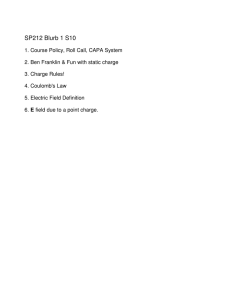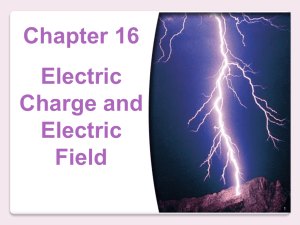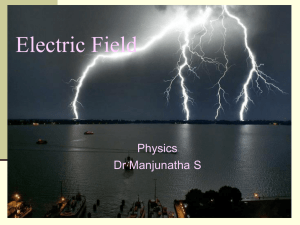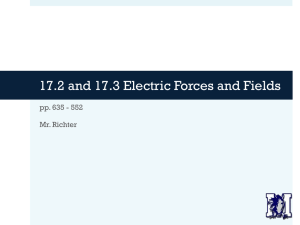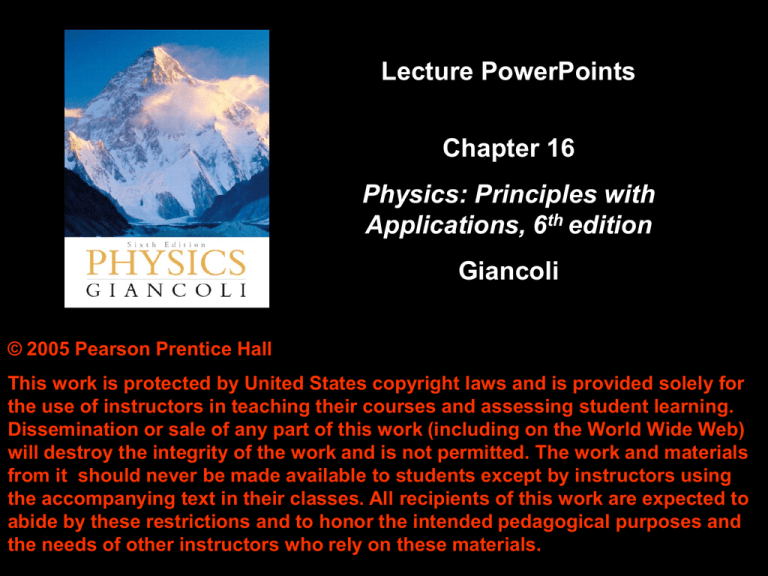
Lecture PowerPoints
Chapter 16
Physics: Principles with
Applications, 6th edition
Giancoli
© 2005 Pearson Prentice Hall
This work is protected by United States copyright laws and is provided solely for
the use of instructors in teaching their courses and assessing student learning.
Dissemination or sale of any part of this work (including on the World Wide Web)
will destroy the integrity of the work and is not permitted. The work and materials
from it should never be made available to students except by instructors using
the accompanying text in their classes. All recipients of this work are expected to
abide by these restrictions and to honor the intended pedagogical purposes and
the needs of other instructors who rely on these materials.
Chapter 16
Electric Charge and
Electric Field
16.1 Static Electricity; Electric Charge
and Its Conservation
Objects can be charged by rubbing
16.1 Static Electricity;
Electric Charge and Its
Conservation
Charge comes in two
types, positive and
negative; like charges
repel and opposite
charges attract
16.1 Static Electricity; Electric Charge
and Its Conservation
Electric charge is conserved – the
arithmetic sum of the total charge cannot
change in any interaction.
16.2 Electric Charge in the Atom
Atom:
Nucleus (small,
massive, positive
charge)
Electron cloud (large,
very low density,
negative charge)
16.2 Electric Charge in the Atom
Atom is electrically neutral.
Rubbing charges objects by moving electrons
from one to the other.
16.2 Electric Charge in the Atom
Polar molecule: neutral overall, but charge not
evenly distributed
16.3 Insulators and Conductors
Conductor:
Insulator:
Charge flows freely
Almost no charge flows
Metals
Most other materials
Some materials are semiconductors.
16.4 Induced Charge; the Electroscope
Metal objects can be charged by conduction:
16.4 Induced Charge; the Electroscope
They can also be charged by induction:
16.4 Induced Charge; the Electroscope
Nonconductors won’t become charged by
conduction or induction, but will experience
charge separation:
16.4 Induced Charge; the Electroscope
The electroscope
can be used for
detecting charge:
16.4 Induced Charge; the Electroscope
The electroscope can be charged either by
conduction or by induction.
16.4 Induced Charge; the Electroscope
The charged electroscope can then be used to
determine the sign of an unknown charge.
16.5 Coulomb’s Law
Experiment shows that the electric force
between two charges is proportional to the
product of the charges and inversely
proportional to the distance between them.
16.5 Coulomb’s Law
Coulomb’s law:
(16-1)
(compare this equation with the one on the formula sheet)
This equation gives the magnitude of
the force.
16.5 Coulomb’s Law
The force is along the line connecting the
charges, and is attractive if the charges are
opposite, and repulsive if they are the same.
16.5 Coulomb’s Law
Unit of charge: coulomb, C
The proportionality constant in Coulomb’s
law is then:
Charges produced by rubbing are
typically around a microcoulomb:
16.5 Coulomb’s Law
Charge on the electron:
(This is also the charge on a proton)
Electric charge is quantized in units
of the electron charge.
16.5 Coulomb’s Law
The proportionality constant k can also be
written in terms of
, the permittivity of free
space:
(on formula sheet)
(16-2)
16.5 Coulomb’s Law
Coulomb’s law strictly applies only to point charges.
Superposition: for multiple point charges, the forces
on each charge from every other charge can be
calculated and then added as vectors.
16.6 Solving Problems Involving
Coulomb’s Law and Vectors
The net force on a charge is the vector
sum of all the forces acting on it.
Calculate Fnet on Q3
Calculate Fnet on Q3
16.7 The Electric Field
The electric field is the
force on a small charge,
divided by the charge:
(on formula sheet)
Units are N/C
If q is positive, F and E will point in the same
direction. If q is negative, F and E will point in
opposite directions.
Force exerted by charge +Q on a small test charge, q, placed at
points a, b, and c. What would be different if the charge was –Q?
16.7 The Electric Field
For a point charge:
(16-4a)
(16-4b)
16.7 The Electric Field
Force on a point charge in an electric field:
(16-5)
Superposition principle for electric fields:
A copier works by arranging
positive charges in a pattern on
the surface of a drum. The
negative toner particles stick to
the pattern on the drum and are
later transferred to paper and
melted to produce the copy.
Photocopy Machines and Computer
Printers Use Electrostatics
Photocopy Machines and Computer
Printers Use Electrostatics
Laser printer is similar, except a computer
controls the laser intensity to form the image
on the drum
Calculate the magnitude and direction of the electric field at point P.
E=?
E=?
Determine the direction and magnitude of the electric field at point P.
If an electron is placed at rest at P and then released, what will be its
initial acceleration?
Calculate the electric field at points A and B.
16.8 Field Lines
The electric field can be represented by field
lines. These lines start on a positive charge
and end on a negative charge.
16.8 Field Lines
The number of field lines starting (ending)
on a positive (negative) charge is
proportional to the magnitude of the charge.
The electric field is stronger where the field
lines are closer together.
16.8 Field Lines
Electric dipole: two equal charges, opposite in
sign:
Electric field lines for four arrangements of charges.
16.8 Field Lines
The electric field between
two closely spaced,
oppositely charged parallel
plates is constant.
16.8 Field Lines
Summary of field lines:
1. Field lines indicate the direction of the
field; the field is tangent to the line.
2. The magnitude of the field is proportional
to the density of the lines.
3. Field lines start on positive charges and
end on negative charges; the number is
proportional to the magnitude of the
charge.
The Earth’s gravitational field
16.9 Electric Fields and Conductors
The static electric field inside a conductor is
zero – if it were not, the charges would move.
The net charge on a conductor is on its
surface.
16.9 Electric Fields and Conductors
The electric field is
perpendicular to the
surface of a conductor –
again, if it were not,
charges would move.
What is the field like inside the metal box?
This applies to safety in a storm.
Electric Forces in Molecular Biology:
DNA Structure and Replication
Replication: DNA is in a “soup” of A, C, G, and T in
the cell. During random collisions, A and T will be
attracted to each other, as will G and C; other
combinations will not.



